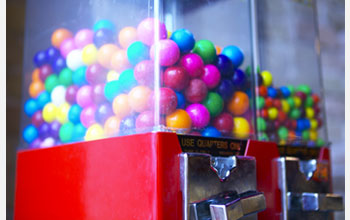News Release 09-146
NYU Physicists Make Room for Oddballs
New research on random packing could mean big advance for industry

Physicists verify a new way to determine how many odd-shaped particles can fit into a container.
August 3, 2009
This material is available primarily for archival purposes. Telephone numbers or other contact information may be out of date; please see current contact information at media contacts.
Here's a question. How many gumballs of different sizes can fit in one of those containers at the mall so as to reward a well-spent quarter? It's hard to believe that most people never consider it even when guessing the number of candies in a bowl at Halloween.
But physicists at the Materials Research Science and Engineering Center at New York University recently developed a new way to help answer the question. They say the solution is found in how the particles pack in terms of how many neighboring gumballs a single gumball can randomly touch within a given container.
Though it may seem intuitive, confirming the answer has long proven elusive because of super complex geometry when dealing with three-dimensional objects of mixed sizes and shapes. But in a recent breakthrough, researchers Maxime Clusel, Eric Corwin and Alex Siemens led by NYU physics professor Jasna Brujic, derived and tested a statistical model that potentially could help industry sort through a variety of packing problems from gumballs in vending machines to grain storage in silos or dry clothes detergent in retail boxes.
"We have discovered a simple organizing principle for particulate packing that predicts our experimental findings," said Brujic. The latest issue of the journal Nature reports the findings. The National Science Foundation funds the research.
The new model predicts the geometry of randomly packing spheres of different sizes in terms of how many nearest neighbors a particle can have, how far apart those neighbors can be and how free space is distributed throughout the packing. It does all this by determining geometric possibilities from the viewpoint of a single particle, which the authors term the "granocentric" view.
"Bigger particles pack with more neighbors, while smaller particles have on average fewer neighbors," said Corwin, a postdoctoral research fellow. "By combining this simple insight with probabilistic mathematics we created an accurate model demonstrating how this organizing rule gives rise to packings where particles have a wide range or distribution of contacts, neighbors and local densities."
The research team used a two step process to verify the model. First they used a 3-D microscope to spy how oil droplets packed together in water. The research enabled the team to determine the number of nearest neighbors the oil droplets could have and other parameters. Then they compared what they found to what was predicted by the statistical model.
"We were surprised to find that such a simple model, based on physical intuition alone, could capture the properties of a complex packing of droplets in an emulsion," Brujic said.
The model predicted the percentage of space occupied by the particles in a container, such that researchers could statistically estimate the number of particles without knowing all the positions of the particles.
The structure of a packing of spheres of equal size is an old problem, whose complexity has challenged mathematicians and physicists for centuries. At first one would think that the structure of packings of spheres of random sizes is even more complex, but surprisingly, the researchers discovered that this is not the case.
The results could be used in a variety of industrial packing processes. For example, the model could be used to determine how finely to mill medicines that pharmaceutical companies pack into drug capsules, producing more effective pills that are smaller and easier to swallow.
"Packing problems are ubiquitious in industry," said Corwin. "An unexpected area of application might be to the world of paint creation. Paint is composed of small particles of pigment suspended in a fluid. As the fluid evaporates the particles are packed tighter and tighter, slowing down the evaporation of the fluid. Thus, one could tune the distribution of particle sizes to achieve paint with particular drying characteristics."
The research was conducted at NYU's Center for Soft Matter.
-NSF-
Media Contacts
Bobbie Mixon, NSF, (703) 292-8485, email: bmixon@nsf.gov
James Devitt, New York University, (212) 998-6808, email: james.devitt@nyu.edu
Program Contacts
Rama Bansil, NSF, (703) 292-8562, email: rbansil@nsf.gov
Principal Investigators
Jasna Brujic, New York University, (212) 998-3586, email: jb2929@nyu.edu
The U.S. National Science Foundation propels the nation forward by advancing fundamental research in all fields of science and engineering. NSF supports research and people by providing facilities, instruments and funding to support their ingenuity and sustain the U.S. as a global leader in research and innovation. With a fiscal year 2023 budget of $9.5 billion, NSF funds reach all 50 states through grants to nearly 2,000 colleges, universities and institutions. Each year, NSF receives more than 40,000 competitive proposals and makes about 11,000 new awards. Those awards include support for cooperative research with industry, Arctic and Antarctic research and operations, and U.S. participation in international scientific efforts.
Connect with us online
NSF website: nsf.gov
NSF News: nsf.gov/news
For News Media: nsf.gov/news/newsroom
Statistics: nsf.gov/statistics/
Awards database: nsf.gov/awardsearch/
Follow us on social
Twitter: twitter.com/NSF
Facebook: facebook.com/US.NSF
Instagram: instagram.com/nsfgov


